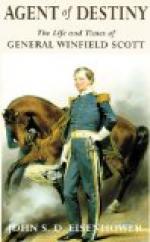General Brown resumed command on September 2d, and determined to attempt to relieve the siege by a sortie on the enemy’s works. The investment had now lasted fifty days, and the British during that time had erected two batteries and were engaged on a third. The force was divided into three brigades, two of which were encamped out of range of the American cannon. At half past 2 P.M. on the 17th the American troops marched out and the action began. In less than half an hour the Americans had captured two of the batteries and two blockhouses. Very soon a third battery was abandoned, the cannon spiked and dismounted. General Drummond retired on the night of the 21st, and took post in his intrenchments behind the Chippewa. The British losses in this investment were, in killed, wounded, and prisoners, nearly a thousand, while the American loss was five hundred and eleven. Early in November the American army took up winter quarters in Buffalo, and this brought to a close the war on the Niagara.
The following statement of the losses on either side in this memorable campaign is interesting:
--------------------------------------+---------------+
--------------- | British loss. | American loss. --------------------------------------+---------------+-----
---------- Battle of Chippewa, July 5, 1814 | 507 | 328 Battle of Niagara, July 25, 1814 | 878 | 860 Battle of Fort Erie, August 15, 1814 | 905 | 84 Sortie from Fort Erie, Sept. 17, 1814 | 800 | 511 +---------------+--------------- Total | 3,090 | 1,783 --------------------------------------+---------------+-----
----------
General Jacob Brown, the commander of this army, became General in Chief of the United States army March 10, 1821. He died September 24, 1828. General Brown was born in Bucks County, Pennsylvania, May 9, 1775. He was secretary to Alexander Hamilton, where he acquired military information and experience, and in 1809 was made a colonel of militia. In 1810 he was promoted brigadier general, and two years afterward was assigned to the command of the frontier from Oswego to Lake St. Francis. In July, 1813, he was appointed a brigadier general in the United States army and placed in command of the Army of Niagara with the rank of major general. His subsequent career is briefly mentioned in this work. He received the thanks of Congress, November 3, 1814, and a gold medal, now in possession of his son, General N.W. Brown, of Washington City.
General Eleazer W. Ripley became a brevet major general, and resigned in May, 1820. He was a member of the House of Representatives of the United States Congress (the Twenty-fourth) from Louisiana, and died March 2, 1839. Hugh Brady became a brigadier general by brevet. William McRee resigned as colonel in March, 1819; was afterward surveyor general of Missouri, and died in 1832. Thomas S. Jesup became quartermaster general of the army with rank of brevet major general. Henry Leavenworth died a brigadier general by brevet, July 21, 1834. John McNeil resigned as brigadier general by brevet; was afterward surveyor of customs at Boston. Jacob Hindman died a colonel, February 17, 1827. Roger Jones was adjutant general of the army, and brigadier general by brevet.




